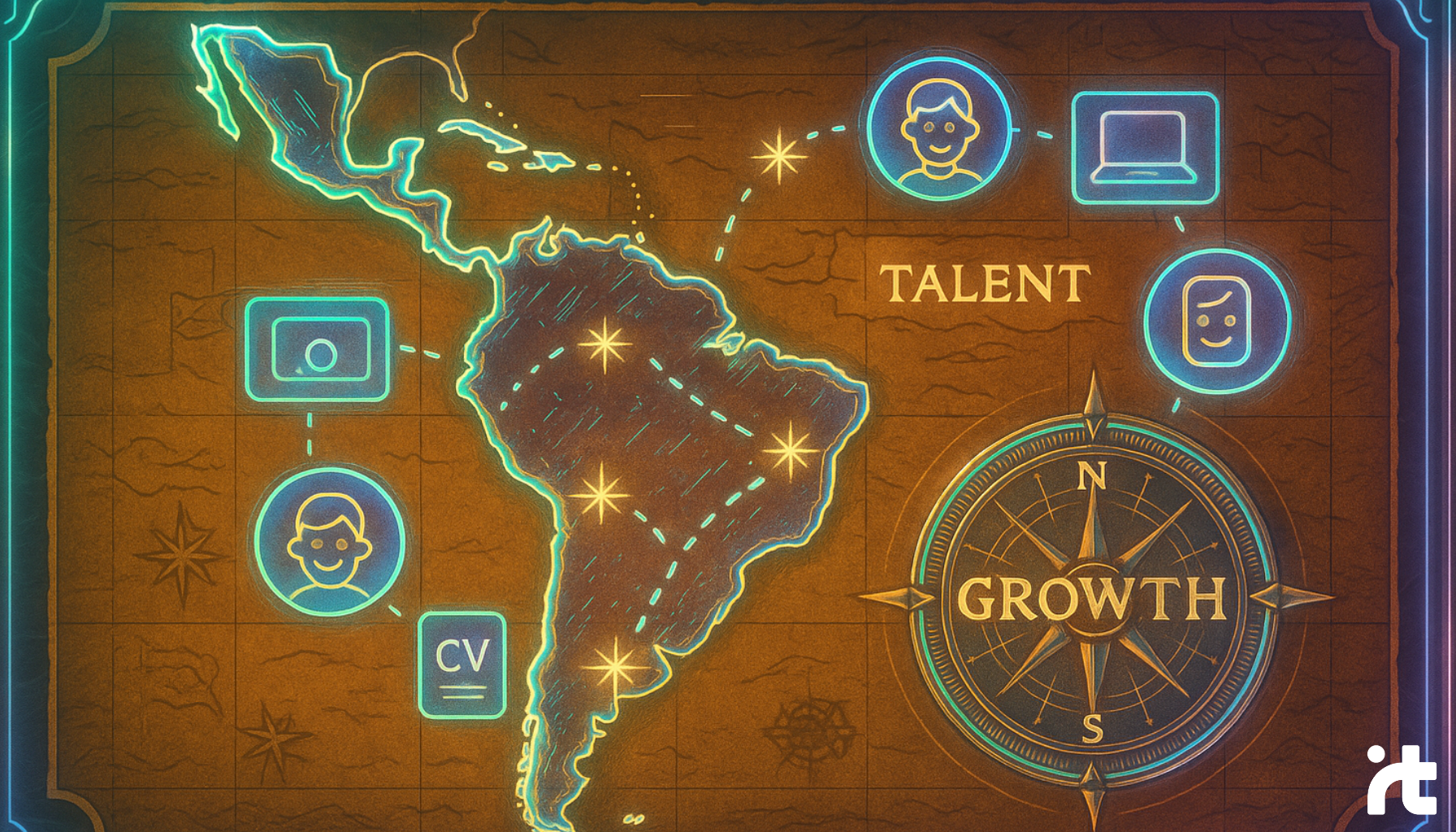An engaging look at the technology that transforms businesses and builds bridges across cultures
Artificial Intelligence (AI) has become the driving force of digital transformation on a global scale. Its innovative flashes captivate companies eager for the next big technological leap, especially in Latin America, a region brimming with energy and exceptional human talent.
But why are U.S. companies increasingly turning their attention to Latin America? The answer is simple: a passion for science converges with an unwavering determination to tackle challenges head-on.
Within this context, Interfell emerges as an HR consulting firm specializing in remote IT talent acquisition in both LATAM and Spain. With more than eight years of experience, Interfell has become a dynamic bridge between the ambitions of U.S. companies and the extraordinary talent in Latin America.
Read on for an overview of the five most coveted AI skills U.S. companies are looking for when hiring professionals in Latin America. We’ll present statistics, tables, and insightful data to help you understand the driving force behind AI and why the region has become the perfect muse for global technological development.
1. Machine Learning
Machine Learning is not just the backbone of AI; it is its lifeblood. It’s all about algorithms that, much like a curious mind, learn from data and improve with every piece of feedback.
- Most Common Applications: Fraud detection, recommendation engines, predictive analytics, and personalization systems.
- Why It’s Essential: In a fiercely competitive environment, anticipating trends and adapting quickly are crucial for business survival.
According to the Global AI Talent Report 2023 by Element AI, the demand for Machine Learning professionals has grown by 48% globally in the past year. In Latin America, talent costs tend to be more accessible, and the region boasts prestigious universities and research centers, such as Tecnológico de Monterrey (Mexico) and the University of São Paulo (Brazil)
Below is a comparative table of AI job demand in Latin America based on data from the IBM Global AI Adoption Index Report (December 2023).
AI Job Demand in Latin America
2. Natural Language Processing (NLP)
Language is a beautiful dimension that gives voice to our ideas, and now, thanks to AI, machines can understand and process it with astonishing precision. Natural Language Processing (NLP) bridges our emotional world and the computational universe.
- Most Common Applications: Chatbots, virtual assistants, sentiment analysis, and automated translation systems.
- Why It’s Essential: It provides the ability to understand context and linguistic and cultural nuances, optimizing customer experience and service efficiency.
According to Gartner, the global NLP technology market will grow at a compound annual rate of 21% through 2025. This growth is especially strong in Latin American countries due to linguistic diversity and the need for services in Spanish and Portuguese. Hiring local experts is, therefore, a strategic move for U.S. companies looking to better connect with Spanish-speaking audiences and customers.
3. Computer Vision
Another key pillar of modern AI is the ability to “see” and “understand” images, video, and other visual signals. Computer Vision has become a valuable ally for a wide range of industries, from manufacturing and precision agriculture to e-commerce and healthcare.
- Most Common Applications: Image and facial recognition, medical imaging diagnostics, autonomous vehicles, and quality control in factories.
- Why It’s Essential: It delivers efficiency and accuracy in processes where human vision is limited or where automation is critical.
A McKinsey study titled “The Future of Work in Latin America” notes that the adoption of computer vision technologies in Latin America grew by 38% over the past year, with a strong emphasis on the manufacturing and logistics sectors. This demand has spurred the creation of tech innovation hubs in cities such as Guadalajara (Mexico), Medellín (Colombia), and Florianópolis (Brazil).
4. AI-Driven Automation
Automation is like a gentle breeze that can quickly grow into a powerful gust. At its most advanced level, AI-driven automation brings together Machine Learning algorithms, NLP, and other areas of AI to orchestrate end-to-end processes with minimal human intervention.
- Most Common Applications: Intelligent CRM, customer support processes, inventory management, and industrial quality control.
- Why It’s Essential: It reduces costs, minimizes errors, and boosts productivity in environments where speed and accuracy are paramount.
According to “Automation with AI: Worldwide Market Analysis” by Grand View Research, AI-driven automation is projected to grow by more than 35% annually through 2026. For U.S. companies, Latin America offers a unique opportunity to work with engineers and developers experienced in integrating AI solutions into existing business frameworks.
5. Data Science and Advanced Analytics
Last but certainly not least, data science and advanced analytics are the lighthouses guiding strategic decision-making. If AI is the engine, data is the fuel—and those who can interpret it are the captains steering the ship toward innovation.
- Most Common Applications: Predictive market models, customer behavior analysis, operational optimization, and generating insights for decision-making.
- Why It’s Essential: It helps organizations navigate a sea of information with clarity, turning data into tangible competitive advantages.
IBM estimates that 2.5 quintillion bytes of data are generated worldwide every day, and the advanced analytics sector in Latin America is expected to grow at a rate of 30% annually. Having professionals who can ride this wave of data is a top priority for companies aiming to stay globally competitive.
___________________________________________________________________________
If you want to know how to hire the Best AI Talent in Latin America?
click HERE
___________________________________________________________________________
Why Has Latin America Become a Hotbed for AI Talent?
- University Education and Government Incentives: Countries like Mexico, Colombia, and Chile have fostered scholarships, university programs, and partnerships with tech companies to develop AI talent.
- Economic Advantage: Salaries in Latin America can be more competitive for U.S. companies without compromising the quality of talent.
- Culture of Innovation: There’s a surge in tech startups, coworking spaces, and entrepreneurship events, fueling a vibrant ecosystem.
This is where Interfell plays a crucial role. Specializing in HR consulting for remote IT talent in LATAM and Spain, Interfell provides hands-on support and deep market expertise. They guide U.S. companies in finding professionals who not only master AI fundamentals but also align with organizational philosophy and values.
Summary Table: The 5 Most In-Demand AI Skills
Source: Combined data from Element AI, McKinsey, and Grand View Research
Final Thoughts
In the grand digital transformation symphony, Latin America stands out as a vibrant stage where AI talent composes increasingly innovative performances.
For U.S. companies, finding professionals who can orchestrate solutions involving machine learning, NLP, or intelligent automation has become a winning strategy for maintaining global competitiveness.
In this process, HR consulting firms like Interfell, backed by years of experience recruiting remote IT talent in LATAM and Spain, function like master tuning specialists, ensuring the perfect match for every business need.
When an organization discovers the magic of a diverse and remote team, it realizes that national borders are merely lines on a map. After all, collaboration transcends distance, and AI, with its promise of innovation, becomes the bridge that connects aspirations to reality.
Are you ready to take the next big step and transform your company with the best AI talent in Latin America?
Interfell Related Articles:





